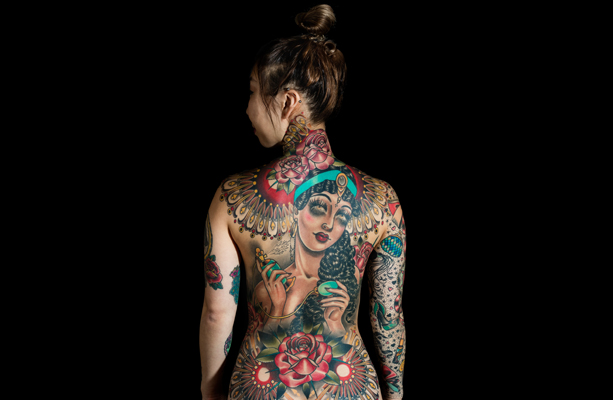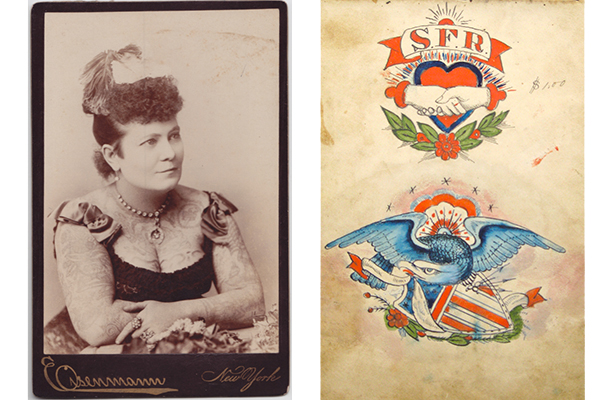What do Dorothy Parker, Theodore Roosevelt, and the 18th century Native American King of the Maquas have in common? First, they were all New Yorkers. Second, they all wore tattoos. Why does Macy’s have a red star logo? Founder R.H. Macy got one tattooed on his hand while working on a whaling ship.
“Tattooed New York,” on view until April 30 at the New York Historical Society, takes visitors through over 300 years of tattoo history. New York’s prominence in the craft’s artistry and business provides a wealth of stories and characters. Even if you’ve never had or wanted a tattoo, you’ll be drawn in (pardon the pun) to this richly textured exhibit.

Featuring over 250 artifacts, the show includes artwork, tattoo machinery, sideshow banners, photographs, videos, and interactive slideshows. Anyone squeamish might want to avoid perusing the tattoo needles and Thomas Edison’s electric pen.
Native Americans in the Northeast wore tattoos as body art and tribal identification. Soldiers’ and sailors’ tattoos were wartime souvenirs. Pigs, roosters, and anchors were good luck charms, but ladies were popular, too. After the U.S. Navy banned tattoos of naked women in 1909, artists made big money by covering racy figures with clothing!

Real women are the focus of “Women and Tattoos.” Victorian socialites, however primly dressed, loved their tattoos. Lady Randolph Churchill, Winston Churchill’s American mother, discreetly covered her snake tattoo with a bracelet.
By contrast, tattoo art elevated lower class women to independence and fame. Some appeared in carnival sideshows, and others “worked both sides of the needle.” Riveting photographs and stories reveal that Nora Hildebrandt had 300 body tattoos, and Ethel Martin Vangi displayed the Statue of Liberty and Abe Lincoln.
With over 500 tattoos, Betty Broadbent wore Charles Lindbergh on her right leg and Pancho Villa on her left. Betty appears photographed in all her inked glory at the 1939 World’s Fair in Flushing Meadow, Queens. And be sure to watch Groucho Marx merrily singing “Lydia The Tattooed Lady” from the 1939 film “At the Circus.”
The Bowery became tattoo central in the 1850s when Martin Hildebrandt opened the first tattoo parlor (he and Nora weren’t related, though he inked her and she took his name). The gritty neighborhood, where artists rented cheap rooms in the backs of barber shops, comes to life in vintage photographs and a 1956 film “On the Bowery.” Charlie Wagner, “the Michelangelo of Tattooing,” had a 50-year career there until his death in 1953. He had apprenticed to Samuel O’Reilly, who patented the first tattooing machine in 1891.
When the New York City health department banned tattooing in 1961, it underestimated New York’s spirit of resistance. As the exhibit explains, tattoo artists and their clients refused to vanish. They simply went underground in the city or to nearby Long Island and New Jersey, until the ban was lifted in 1997.
Modern tattooing has gone mainstream, and New York artists continue to thrive. Large color photographs show astonishingly creative body art. Breast cancer survivors’ tattoos and 9/11 memorial tattoos reveal their power to inspire. In a concluding film, current tattoo artists describe and demonstrate their evolving craft.
So, what, and where, were Dorothy Parker’s and Teddy Roosevelt’s tattoos? Dorothy wore a small blue star on her left arm, and T.R. had his family crest inked on his chest.
Would love to know. Share below!
By: Lois Farber

Jessica Tiare Bowen lives in the juicy Big Apple with her adorable pink-nosed chihuahua, Gillman. He’s the inspiration for her first published children’s book, “Park Avenue Pound Puppy.” The book is the combined result of her two greatest passions: pooches and penning stories.
Her passions include art, urban hikes through Manhattan, drinking coffee with 3 creams and 6 sugars, making extremely detailed itineraries and traveling to far away places, singing along to Broadway shows, Netflix movie nights, discovering incredible treasures at Goodwill and thrift stores, and listening to stories from little people under 7 and big people over 70.
She started her career as New York City Teaching Fellow, teaching elementary school and theater arts at a special education school in the South Bronx for 6 years. She is now a Special Education School Improvement Specialist working in public schools throughout New York City. She is the Editor-In-Chief of the online New York City travel magazine, Used York City. The magazine focuses on finding the best of New York…as used by New Yorkers. She is a member of the Society of Children’s Book Writers and Illustrators, and an ASPCA Ambassador.








